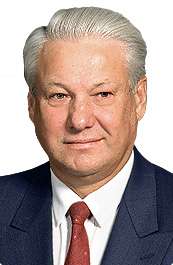Impeachment in Russia
Impeachment of the President of the Russian Federation — initiated by the Parliament's legal procedure, providing for the termination of the Russian President of his powers.
The impeachment procedure was carried out three times. All three times it was held against President Boris Yeltsin, and all three times had failed.
Legal procedure
In accordance with the current Russian legislation, the removal from office of the President are regulated by article 93 of the Constitution.[1] It provides for indictment by the State Duma, should be accompanied by the opinion of the Supreme Court of Russia and Constitutional Court of Russia on observance of prescribed procedure for charging. The decision to impeach the President accepts the Federation Council.
The decision of the State Duma on bringing charges and the decision of the Federation Council on dismissal of the President from office must be adopted by two-thirds of the total number in each of chambers (300 and 114 respectively) on the initiative of not less than one third (150) of deputies of the State Duma and with the conclusion of the special Commission formed by the State Duma. The decision of the Federation Council on impeachment of the President of the Russian Federation from office must be adopted not later than within three months after the extension of the State Duma of the charges against the President. If within this period the Federation Council's decision is not accepted, charges against the President shall be considered rejected.
Impeachment history
| Date | President | Accusation(s) | Result |
|---|---|---|---|
| March 28, 1993 |  |
Violation of the Constitution | Impeachment is not adopted, as the vote for impeachment by the deputies failed to reach the 689 majority (617/689). |
| September 22, 1993 | Violation of the Constitution | Boris Yeltsin de jure was dismissed, and the performance of duties of the President have been entrusted to the Vice President Alexander Rutskoy. However, Yeltsin de facto remained in office and declared the dissolution of the Supreme Soviet. Later, the conflict escalated into armed confrontation, which resulted in Yeltsin retaining his power.[2] See 1993 Russian constitutional crisis | |
| May 11–15, 1999 |
|
Impeachment is not adopted, as none of the charges had achieved the required 300 votes. The charge which achieved the highest number of votes was that concerning the War in Chechnya, which obtained 283 votes.[3] |
See also
- Nikita Khrushchev, the only Soviet leader to be removed from power by Supreme Soviet.
References
- Article 93 of the Constitution of the Russian Federation
- Постановление Верховного Совета Российской Федерации № 5780-I от 22 сентября 1993 года «О прекращении полномочий Президента Российской Федерации Ельцина Б. Н.»
- ИМПИЧМЕНТ (Специальные корреспонденты “Завтра” ведут репортаж из Государственной думы)